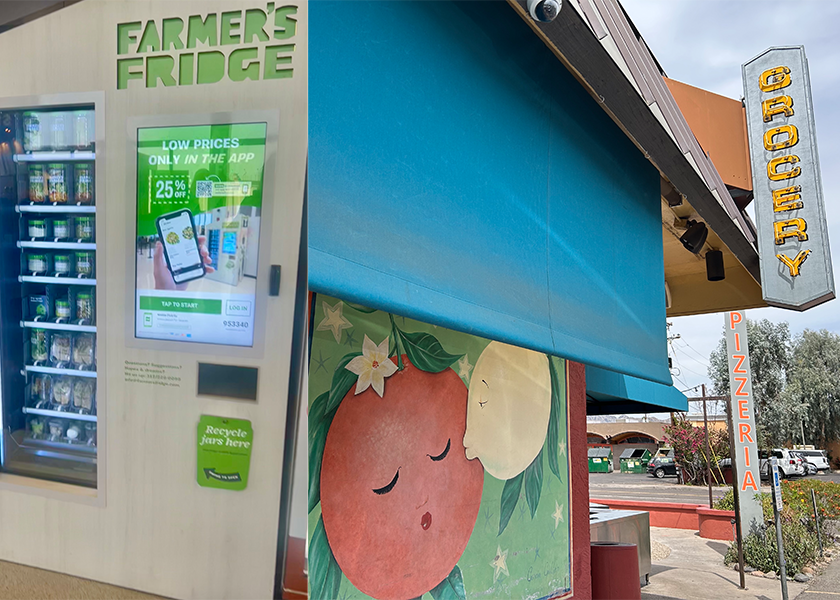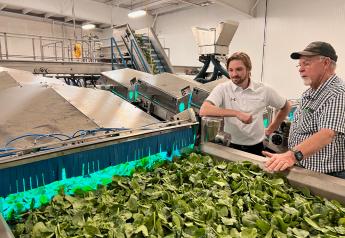You can sell produce … where?

The line between retail and foodservice blurs when you find fresh fruits and vegetables in less obvious spaces and places. Today’s and tomorrow’s shoppers want convenience. And what’s more convenient than produce everywhere you turn?
“I think ubiquity has a really negative connotation, but in this space, it's just tons of fruits and veggies,” said Sarah Kiel, Yale Hospitality health and wellness manager, formerly a registered dietitian at Harmons Grocery, based in West Valley City, Utah.
Don’t miss opportunities to branch out and grow your produce sales.
Vending machines
Examples: Farmers Fridge, dubbed “The smallest restaurant in the world,” is a smart vending machine that sells jarred salads as well as grain bowls and wraps filled with vegetables, found at public spaces with a lot of foot traffic, such as the Chicago O’Hare Airport. The touch screen lets people browse available items and see full nutrition information. The built-in recycling bin accepts jar returns; meals are kept cool in the refrigerated area; and food is regularly restocked and won’t vend if it’s not fresh.
In March, Daily Blend nabbed $2 million in capital and a partnership with Metrolinx, the largest public transit system in Toronto, to install smart vending machines powered by artificial intelligence to sell fresh salads and other produce-filled items.
Gas stations and convenience stores
Examples: Convenience stores — stand-alone and attached to gas stations — are operated independently and by large grocery retailers, and they’re adding more fresh produce, a bit at a time. 7-Eleven, the largest convenience store in the U.S. with 13,000 locations, stocks bananas, fresh-cut fruit and salads.
In April, San Antonio-based H-E-B rebranded its gas station convenience stores as H-E-B Fresh Bites to provide shoppers more fresh options, such as produce and prepared food.
Resort and hotel mini-marts have single-serve versions of produce. Average order values at convenience stores may be lower than at supermarkets, but the category has a higher likelihood of repeat purchases in a short span of time.
Sports arenas
Examples: Citizens Bank Park, home of the Philadelphia Phillies, has Bowery’s read-to-eat Zesty Caesar Salad Kits available at the stadium for the whole baseball season.
SnapDragon apples, the first official apple of the NFL’s Buffalo Bills, were sold during football season at Highmark Stadium.
Announced the summer of 2022, AvoEats by Avocados From Mexico concessions are at stadiums hosting football, basketball, tennis, baseball and more, in top markets such as Boston, Dallas, Green Bay, Los Angeles and Miami.
RESTAURANTS AND COFFEE SHOPS
Examples:
Fresh produce sections at restaurants and cafes are another increasingly powerful way to build brand loyalty. To survive amid COVID-19-related dining room closures, some restaurants transformed into local grocery stores. Many of these hybrid operations continue.
Starbucks and local, independent coffee shops often have grab-and-go whole bananas and apples. Starbucks also has Evolution Fresh cold-pressed vegetable and fruit juice, now owned by Bolthouse Farms.
Chocolatier and coffee shop Mast Brothers in Mount Kisco, N.Y., has a small fresh market with leafy greens, root vegetables, apples, berries — whatever is in season locally.
Farmers markets, farm boxes
Examples: Farmers markets are growing more sophisticated, accepting Supplemental Nutrition Assistance Program (SNAP) benefits and allowing pre-ordering for convenient tent-side pickup.
In January, Kroger expanded its Kroger Farmers Market throughout the greater Columbus, Ohio, metro area, a partnership with Market Wagon that began in Atlanta in June 2022 and has also expanded to Knoxville, Tenn. It’s an e-commerce marketplace for local farmers and businesses.
Based in Arroyo Grande, Calif., Talley Farms, a wholesaler for retailers nationwide, has a Talley Farms Box Program since 2012, with about 8,200 subscribers, receiving 3,000 to 4,000 boxes weekly through about 70 pickup locations from Paso Robles to Santa Barbara, plus home delivery and overnight shipping. The program comprises about 15% of farm revenue, said Andrea Chavez, program manager.
Food rescue apps, meal kit delivery
Examples: Several companies combine reducing food waste with the ease of online grocery ordering and delivery, such as subscription-based Imperfect Foods and Misfits Market and pay-per-use Flashfood, offering produce that’s ugly or near the best-before date yet still delicious and safe. Flashfood items are discounted.
By April, there were at least 30 major meal kit and delivery services, according to Epicurious, competing with supermarkets by severely reducing the number of trips or basket volume. We’re thinking HelloFresh, Blue Apron, Sunbasket, Purple Carrot and Hungryroot, to name a few.
Dark stores
Examples: Founded in 2002, FreshDirect, Bronx, N.Y., was one of the first businesses of its kind to sell and deliver fresh produce and other perishables directly to consumers without a retail store: No customers to shop the aisles and no checkout lines because every transaction occurs digitally.
Eventually followed DoorDash’s 164 DashMart stores for midweek grocery-delivery needs, ultrafast grocery delivery services like Gorillas, AmazonFresh, and retailer warehouses used for online orders — all existing solely for delivery purposes.
Related: This story was published in the May-June issue of PMG Magazine. See the digital issue.







